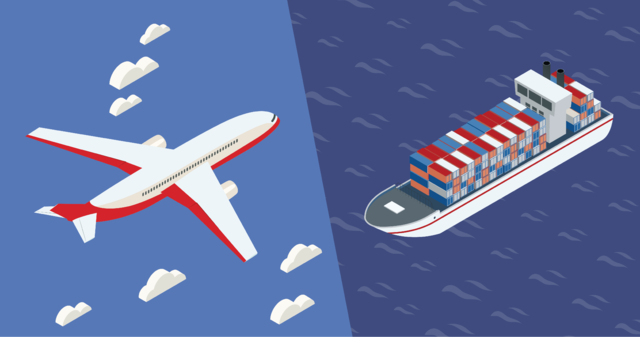- By TOP CHINA FREIGHT
- October 9, 2025
- Amazon FBA, Shipping
Table of Contents
FBA freight China to Japan can be complex and time-sensitive, as sellers often struggle with high shipping costs, customs clearance, and delayed transit times. This guide explores options to help streamline your logistics and improve delivery efficiency.

What Are the Main Shipping Methods for FBA Freight China to Japan?
Choosing the right shipping method is crucial for balancing cost, speed, and reliability. The three primary shipping options are sea freight, air freight, and express courier services.
| Shipping Method | Transit Time | Cost per 20kg | Best For | Pros | Cons |
|---|---|---|---|---|---|
| Sea Freight | 15–25 days | $150–$300 | Bulk shipments | Cost-effective, can handle large volumes | Slower, port handling delays possible |
| Air Freight | 3–7 days | $8–$12 per kg | Medium-sized shipments | Fast, reliable, reduced storage time | Higher cost, weight restrictions |
| Express Courier | 1–3 days | $12–$20 per kg | Small parcels | Door-to-door service, fastest | Expensive, not suitable for large volumes |
Sea freight is ideal for bulk shipments with longer lead times, while air freight is better for medium-sized shipments needing faster delivery. Express courier services are perfect for urgent small parcels.
How to Calculate FBA Freight Costs from China to Japan?

Understanding cost breakdown is essential for accurate budgeting. Costs typically include freight charges, customs duties, FBA prep fees, and additional service fees.
| Cost Component | Description | Typical Rate |
|---|---|---|
| Freight Charge | Cost to move goods to Japan port or airport | $150–$300 per 20kg (sea) |
| Customs Duties | Import taxes on goods | 0–10% depending on category |
| FBA Prep Fees | Labeling, packaging, prep for Amazon | $0.50–$1.50 per unit |
| Handling Fees | Port/airport handling, documentation | $50–$100 per shipment |
Moreover, using a freight forwarder specializing in FBA can help reduce hidden costs by consolidating shipments, optimizing routes, and managing customs efficiently.
What Are the Key Documents Needed for FBA Freight to Japan?

Proper documentation ensures smooth customs clearance and prevents delays. Common documents include:
| Document | Purpose | Notes |
|---|---|---|
| Commercial Invoice | Declares shipment value and description | Required for customs |
| Packing List | Details product quantities and dimensions | Helps with inspection |
| Bill of Lading (B/L) | Proof of cargo shipment | Needed for sea freight |
| Air Waybill (AWB) | Proof of cargo shipment | Needed for air freight |
| FBA Shipment Plan | Amazon-specific | Ensures correct FBA destination |
Additionally, sellers should ensure compliance with Japanese import regulations, labeling, and product certifications, particularly for electronics, cosmetics, and toys.
Why Choose a Professional FBA Freight Forwarder?
Many Amazon sellers underestimate the complexity of international shipping. A professional FBA freight forwarder can:
- Consolidate shipments from multiple suppliers.
- Provide cost-effective shipping routes.
- Handle customs clearance efficiently.
- Offer Amazon-specific prep services, including labeling and packaging.
Moreover, forwarders often provide real-time tracking, ensuring sellers can anticipate delivery schedules and avoid stockouts.
Should You Opt for Air or Sea Freight for FBA Shipments?

The choice between air and sea freight depends on your priorities: speed, cost, and shipment volume.
| Aspect | Air Freight | Sea Freight |
|---|---|---|
| Transit Time | 3–7 days | 15–25 days |
| Cost | High | Low |
| Volume | Medium | Large |
| Reliability | High | Moderate |
| Best For | Urgent or high-value items | Bulk shipments |
Therefore, sellers often combine methods: high-demand items via air freight and bulk inventory via sea freight. This hybrid strategy can optimize cash flow and stock levels.
How Long Does FBA Freight Take from China to Japan?
Transit time varies depending on the shipping method, departure port, and destination.
| Shipping Method | Transit Time | Additional Time Considerations |
|---|---|---|
| Sea Freight | 15–25 days | Customs clearance 2–5 days |
| Air Freight | 3–7 days | Airport handling 1–2 days |
| Express Courier | 1–3 days | Minimal additional time |
Transit time can also fluctuate during peak seasons, such as holidays or promotional events. Planning shipments in advance ensures inventory remains in stock and reduces rush fees.
What Are Common Challenges in FBA Freight China to Japan?
Misdeclared goods or incomplete documentation can hold shipments.
Small parcels shipped individually are costly.
Slow transit can result in stockouts.
Non-compliant labeling or packaging can incur Amazon penalties.
Case Study: Efficient FBA Freight China to Japan

A mid-sized electronics seller in Shenzhen faced frequent delays and high costs shipping to Amazon Japan. By partnering with a specialized FBA freight forwarder:
- They consolidated multiple small shipments into a single sea freight container.
- Air freight was reserved for high-demand gadgets.
- All shipments were FBA-compliant, including labeling and packaging.
Results:
- Shipping costs reduced by 30%.
- Transit time optimized: bulk inventory arrived within 20 days, urgent items in 5 days.
- Stockouts eliminated, leading to a 15% increase in monthly sales.
This demonstrates the importance of tailored logistics solutions for Amazon sellers.
How to Optimize FBA Freight Shipping Costs?
Several techniques help reduce costs without sacrificing delivery speed:
- Consolidate shipments to fill containers fully.
- Compare multiple freight forwarders for competitive rates.
- Choose efficient ports (Shanghai, Ningbo, or Shenzhen).
- Plan shipments ahead to avoid peak-season surcharges.
- Review Incoterms: FOB gives more control over freight and cost.
Additionally, monitoring logistics trends such as seasonal demand and carrier availability can prevent unexpected cost spikes.
Tips for Smooth FBA Freight Delivery to Japan
1.Track Shipments:
Use forwarder tracking systems to anticipate delays.
2.Pre-plan Inventory:
Avoid last-minute air freight fees.
3.Ensure FBA Compliance:
Confirm Amazon Japan’s packaging and labeling requirements.
4.Use Insurance:
Protect high-value shipments from potential loss.
5.Maintain Clear Communication:
Coordinate with suppliers and forwarders regularly.
These proactive steps minimize risk and maintain consistent stock levels for Amazon sellers.
Conclusion
Shipping FBA freight from China to Japan requires careful planning, proper documentation, and strategic shipping methods. By understanding costs, transit times, and logistics challenges, sellers can optimize their supply chain, reduce expenses, and maintain smooth Amazon operations. Partnering with an experienced freight forwarder ensures compliance, timely delivery, and efficient inventory management, giving sellers a competitive advantage in the Japanese market.
Need a Shipping Quote?
If you want expert guidance and peace of mind, our team is ready to assist.
TJ China Freight offers tailored solutions to help businesses of all sizes ship more reliably from China.

FAQ
Q1: Can small parcels be shipped via sea freight to Amazon Japan?
Yes, but sea freight is best for bulk shipments. Small parcels are more cost-effective via air or courier services.
Q2: What documents are mandatory for FBA shipments to Japan?
Commercial invoice, packing list, bill of lading/air waybill, and Amazon FBA shipment plan. Compliance ensures smooth customs clearance.
Q3: How can I reduce FBA freight costs from China to Japan?
Consolidate shipments, choose cost-effective shipping, plan ahead, and work with experienced forwarders.
Q4: Is air freight always better than sea freight for Amazon FBA?
Not always. Air is faster but costlier; sea is cheaper for bulk. A hybrid approach often works best.
Q5: How long does customs clearance take in Japan?
Typically 1–5 days, depending on shipment size and documentation accuracy.
